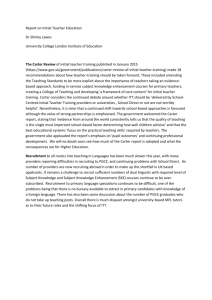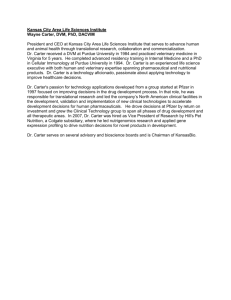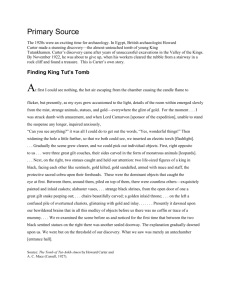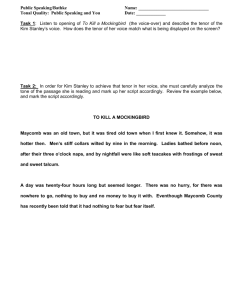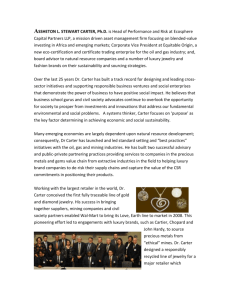chapter1 for ccw site 8-5
advertisement
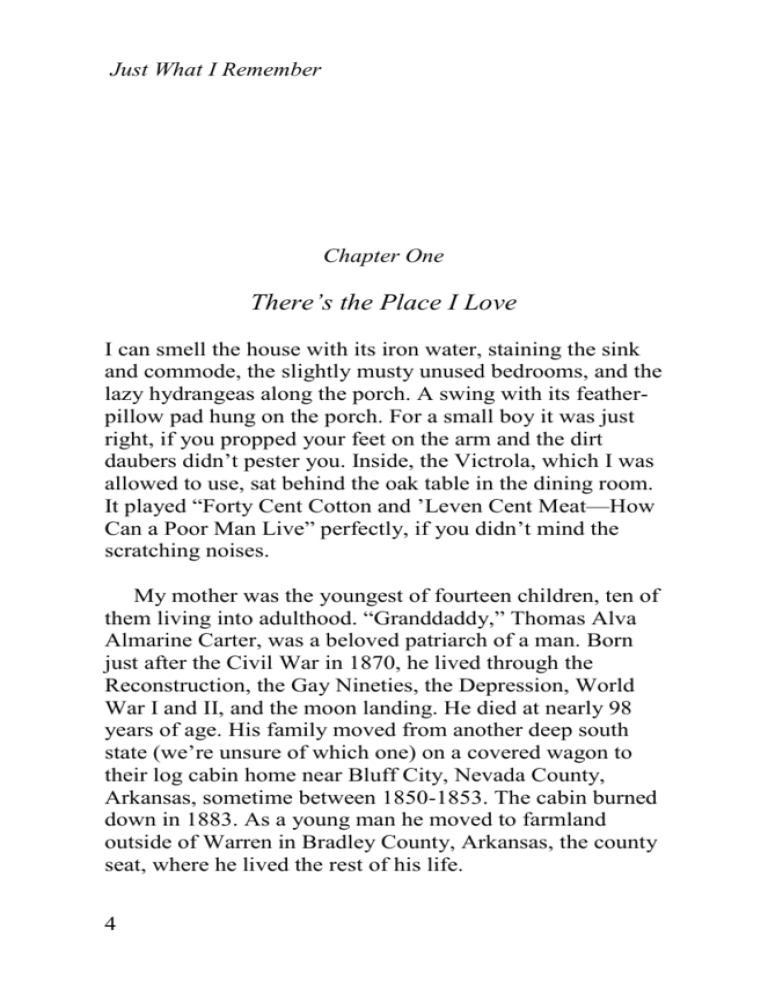
Just What I Remember Chapter One There’s the Place I Love I can smell the house with its iron water, staining the sink and commode, the slightly musty unused bedrooms, and the lazy hydrangeas along the porch. A swing with its featherpillow pad hung on the porch. For a small boy it was just right, if you propped your feet on the arm and the dirt daubers didn’t pester you. Inside, the Victrola, which I was allowed to use, sat behind the oak table in the dining room. It played “Forty Cent Cotton and ’Leven Cent Meat—How Can a Poor Man Live” perfectly, if you didn’t mind the scratching noises. My mother was the youngest of fourteen children, ten of them living into adulthood. “Granddaddy,” Thomas Alva Almarine Carter, was a beloved patriarch of a man. Born just after the Civil War in 1870, he lived through the Reconstruction, the Gay Nineties, the Depression, World War I and II, and the moon landing. He died at nearly 98 years of age. His family moved from another deep south state (we’re unsure of which one) on a covered wagon to their log cabin home near Bluff City, Nevada County, Arkansas, sometime between 1850-1853. The cabin burned down in 1883. As a young man he moved to farmland outside of Warren in Bradley County, Arkansas, the county seat, where he lived the rest of his life. 4 Just What I Remember T. A. built a home for his new bride, Molly Moseley, in 1897. It is still standing, owned by my wealthy, now deceased cousin who died at 101. This cousin, also named Warren, founded the Carter Lumber Companies with its two hundred fifty stores in nine states. The house still has its original exterior, but is refurbished inside. Warren visited there for extended times each year while he surveyed his 60,000 acres of Arkansas timber. That house, a mile away down the dirt and gravel road, was exchanged for the home my mother grew up in not long after T. A. and Molly married T. A. Carter was a school teacher at first. We have his teaching contract with a promise of $1.00 a day in 1898. Later he would become a surveyor, a superintendent of schools (though he never graduated himself), and a county judge. Underneath all of this, he was a farmer with a couple of hundred acres of Bradley County, Arkansas dirt. He was never wealthy, except in children, joy, and Christ. My mother, the pet of the home, was the youngest. Jewel Canille Carter was born in 1916. As a child she looked amazingly like my own daughter, slight and pretty. “Sweet” was the word most often used for my mother. When I read through the inscriptions in the Ouachita (“WASH-a-taw”) College annuals passed down to us, the word “sweet” appeared in almost every one. I believe they had it right. As a child my mother attended the one-room school house a couple of miles away from the home place, just like all her siblings. Her sisters reported that she was only disciplined once, for sticking out her tongue at her father, though she was quite a disciplinarian herself. She claimed that it just did not occur to her to disobey her parents. The older boys were regularly and often disciplined, however. At the end of ten living kids, patterns of obedience were firmly established in the home. 5 Just What I Remember In 1927, in the middle of the school day, ten-year-old Jewel was called home only to find her home burning to ashes. The brothers had completely repainted the home on the inside. After finishing, someone put papers into the fireplace to burn them, causing the conflagration that consumed the house to its foundation. Jewel saw her brothers, sisters, and parents destitute but triumphant. The old home built in the late 1800s was constructed by Uncle Theophilus and exchanged for the one I mentioned earlier. (It was part of family lore that, at his birth, people commented, “My, my, that’s ‘theophilus’ lookin’ baby I’ve ever seen!”) The home had four rooms: the main room which also served as the bedroom for T. A. and Molly, the boys’ room, the girls’ room, and the kitchen, separated from the home just a bit. The “dog run” divided the home down the middle and served as summer eating quarters. A porch ran completely around the home. It was in the main room, the parents’ bedroom, that the fireplace roared, peanuts were eaten, hulls thrown into the fire, and many good times had. My mother said that traveling peddlers would sometimes entertain them, spending the night at their home on their way through. When the fire broke out, people did what they could to drag things out. My aunt Bertie Lee, not thinking clearly, carried a pan full of water out into the yard! The men did their best to remove the brand new Home Comfort stove, wasting precious moments, but were unsuccessful. Everything was lost but their determination. And they were a determined lot. The large family now had to improvise. The parents slept in the blacksmith shop, filled with all the tools forged by T. A.’s father. Others slept in a large tent. Some went to 6 Just What I Remember neighbors’ and relatives’ homes. In seven weeks those sympathetic neighbors helped them build the new house, which still stands. We have the old papers and bills for this home which were kept all these years. We even have the papers for the indoor bathroom which was added in the ’40s as a gift from the kids to the parents. But when I was a boy we still used the “privy” out back on reunion days. We children washed in the big galvanized tub just beside the porch with the well in it. The indoor facilities were just not sufficient for such a crowd. The whole Carter farm was ours to explore. We used to peer into the hog pen as the pigs were being “slopped,” and climb up into the apple trees in the orchard to eat all the green apples we wanted. Or, we’d pick the scuppernongs on the ancient, sturdy arbor in the garden, sometimes sitting on top of it. We could explore the “sweet potato house” and the “peanut house,” no doubt built because of the influence of George Washington Carver. The barn’s hayloft provided hours of entertainment jumping from bale to bale. We could fish in the pond and swim in the little creek, without clothes. We got to draw water out of the well and drink it from the gourd dipper and swing on the cannonballweighted gate. The smoke house was a mysterious place just outside the back screened-in-porch. The bell on the porch called us to meals just as it had our uncles and other farm hands many years earlier. Old Dave, the sway-backed mule, tall and grey dappled, provided some “down home” entertainment as well. He was as much a fixture in the early days as Uncle Howard or Aunt Emily. About six of the cousins piled on the top of Old Dave one day and made a trip of it (I was in the rear). When Dave hit a switch in the woods, he reared back and all of us fell off, landing on the large burrs all over the ground. I remember it well. Uncle Howard would 7 Just What I Remember sometimes hook up the sled to pull kids around with Old Dave’s help. We loved that beast. I could not fully understand when I returned one year why my uncles said, with a low Carter chuckle, that he had been “sold to the glue factory.” We sometimes walked to Great Aunt Effie’s house, my granddad’s sister. That old unpainted shack fell down years ago. She was unmarried and seemed to always be shelling peas. We sat on the porch to help her while we “visited.” She lived just past the wooden bridge down the red dirt road. What memories! I heard a story there from a man I thought was an ancient relative, about how he heard the sounds of the Civil War battle that had taken place close by, and recovered a bugle as a little boy after it was finished. I only remember meeting him once. I have twenty dollars in Confederate money and a note from the Texas Cavalry from those Civil War days. The Texas Cavalry had taken some animals and grains from the Carter farm to feed the troops in exchange for what became worthless Confederate notes. When my family lived nearby in Fordyce, before we moved to Kansas City, we used to make the thirty-minute drive “down home” fairly frequently. I was a preschooler. Later, we would return at least once a year for the big Christmas reunion. It seemed like a hundred people were there. As the six of us would drive down Carter-Evans Road we would always comment on the old blacksmith shop, which gradually melted into the ground before our very eyes, buried in the vines. We would pass the woman’s home who always listened in on the “party line,” the telephone arrangement that made conversations accessible to everyone in the community. Each family had its distinctive series of rings. I believe that the Carter’s ring was one long and two shorts. The graded road would cause 8 Just What I Remember the car to shake as we slowed down, dust flying behind us. And then we turned the corner into the home place. We all strained our eyes to be the first to see the home. Mother might remind us about riding her little pony to that spot as a girl—the pony that would stop right there and go no further. The ten hours in the crowded automobile down two lane highways from Kansas City made no difference as soon as we saw our family home. Years later, when my mother rounded that same corner on her final visit as an Alzheimer’s patient just a short time before her death, she exclaimed, as if coming out of a mental fog, “There’s the place I love!” It was a foretaste of heaven. 9
